Related Research Articles
Kallikreins are a subgroup of serine proteases, enzymes capable of cleaving peptide bonds in proteins. In humans, plasma kallikrein (KLKB1) has no known paralogue, while tissue kallikrein-related peptidases (KLKs) encode a family of fifteen closely related serine proteases. These genes are localised to chromosome 19q13, forming the largest contiguous cluster of proteases within the human genome. Kallikreins are responsible for the coordination of various physiological functions including blood pressure, semen liquefaction and skin desquamation.

Netherton syndrome is a severe, autosomal recessive form of ichthyosis associated with mutations in the SPINK5 gene. It is named after Earl W. Netherton (1910–1985), an American dermatologist who discovered it in 1958.

Pancreatic secretory trypsin inhibitor (PSTI) also known as serine protease inhibitor Kazal-type 1 (SPINK1) or tumor-associated trypsin inhibitor (TATI) is a protein that in humans is encoded by the SPINK1 gene.

Kallikrein-6 is a protein that in humans is encoded by the KLK6 gene.
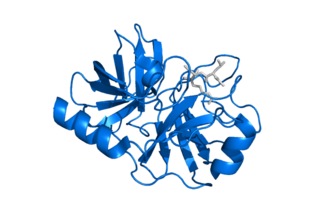
Kallikrein-related peptidase 5 (KLK5), formerly known as stratum corneum tryptic enzyme (SCTE), is a serine protease expressed in the epidermis. In humans it is encoded by the KLK5 gene. This gene is one of the fifteen kallikrein subfamily members located in a cluster on chromosome 19. Its expression is up-regulated by estrogens and progestins. Alternative splicing results in multiple transcript variants encoding the same protein.

Kallikrein-related peptidase 4 is a protein which in humans is encoded by the KLK4 gene.
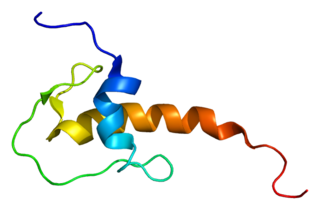
Lympho-epithelial Kazal-type-related inhibitor (LEKTI) also known as serine protease inhibitor Kazal-type 5 (SPINK5) is a protein that in humans is encoded by the SPINK5 gene.

Kallikrein-11 is a protein that in humans is encoded by the KLK11 gene.
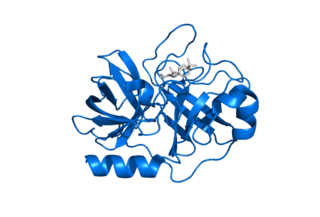
Kallikrein-related peptidase 7 (KLK7) is a serine protease that in humans is encoded by the KLK7 gene. KLK7 was initially purified from the epidermis and characterised as stratum corneum chymotryptic enzyme (SCCE). It was later identified as the seventh member of the human kallikrein family, which includes fifteen homologous serine proteases located on chromosome 19 (19q13).

Kallikrein-13 is a protein that in humans is encoded by the KLK13 gene.
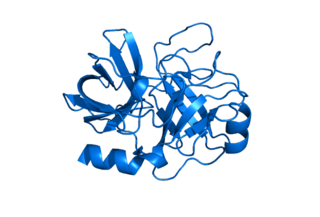
Kallikrein-8 is a protein that in humans is encoded by the KLK8 gene.

Kallikrein-14 is a protein that in humans is encoded by the KLK14 gene.

Kallikrein-15 is a protein that in humans is encoded by the KLK15 gene.

Kallikrein-12 is a protein that in humans is encoded by the KLK12 gene.

Serine protease inhibitor Kazal-type 2 also known as acrosin-trypsin inhibitor is a protein that in humans is encoded by the SPINK2 gene.

WAP, kazal, immunoglobulin, kunitz and NTR domain-containing protein 1 is a protein that is encoded by the WFIKKN1 gene. when found in humans.

Kallikrein-related peptidase 9 also known as KLK9 is an enzyme which in humans is encoded by the KLK9 gene.
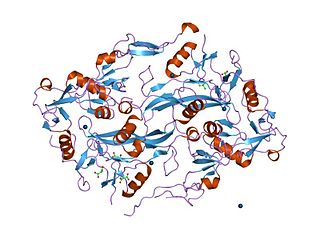
The Kazal domain is an evolutionary conserved protein domain usually indicative of serine protease inhibitors. However, kazal-like domains are also seen in the extracellular part of agrins, which are not known to be protease inhibitors.
Lympho-epithelial Kazal-type related inhibitor 2 (LEKTI-2) is a protein encoded by the SPINK9 gene in humans. LEKTI-2 is an inhibitor of KLK5, a serine protease expressed in the epidermis and responsible for coordinating skin homeostasis and desquamation. SPINK9 is a member of a gene family cluster located on chromosome 5q33.1, which includes SPINK5 and SPINK6.

WAP, follistatin/kazal, immunoglobulin, kunitz and netrin domain containing 2 is a protein that in humans is encoded by the WFIKKN2 gene.
References
- ↑ Meyer-Hoffert U; Wu Z; Kantyka T; Fischer J; Latendorf T; Hansmann B; Bartels J; He Y; Gläser R; Schröder JM. (October 2010). "Isolation of SPINK6 in human skin: selective inhibitor of kallikrein-related peptidases". J Biol Chem. 285 (42): 32174–81. doi:10.1074/jbc.M109.091850. PMC 2952218 . PMID 20667819.
- ↑ Furio L; Hovnanian A. (November 2011). "When Activity Requires Breaking Up: LEKTI Proteolytic Activation Cascade for Specific Proteinase Inhibition". J Invest Dermatol. 131 (11): 2169–73. doi: 10.1038/jid.2011.295 . PMID 21997416.